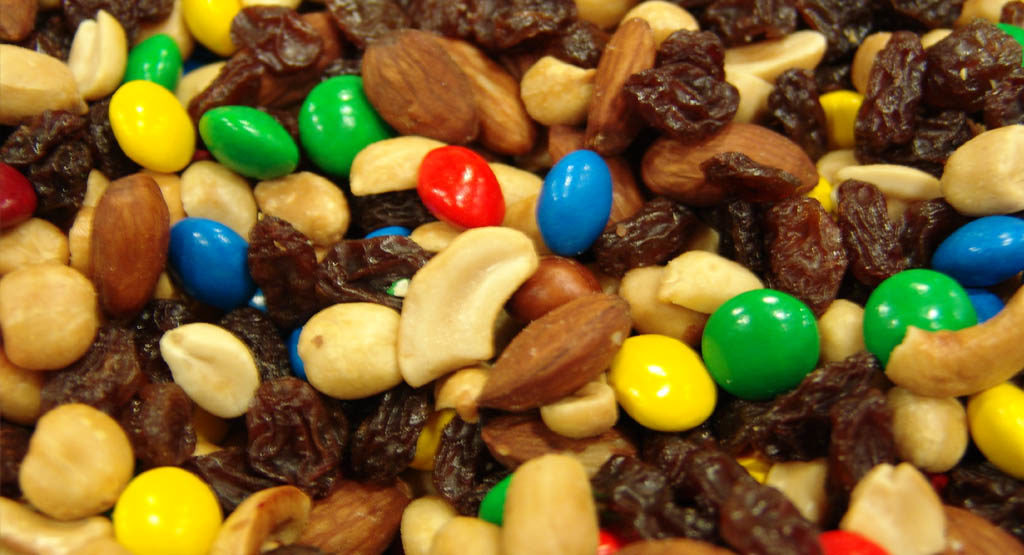What is Trail Mix?
"Trail mix" is the term for a mix of bite-sized ingredients that travels well. Other names for trail mix include gorp, which etymology expert Barry Popik says may be an acronym for "good old raisins and peanuts," and "scroggin," an acronym used in Australia and New Zealand that represents the snack's popular ingredients plus "i" for "imagination." Whatever you call it, trail mix typically includes nuts, seeds and dried fruit tossed together without cooking. It's perfect travel food because no refrigeration is necessary. Hikers, campers and parents of young children like trail mix because it's lightweight and portable.
Why Choose Trail Mix?
It's common knowledge these days that nuts are good for you. They have healthy fats (monounsaturated and polyunsaturated, two types we don't tend to eat much of as Americans). They are also relatively high in fiber and vitamins and minerals.
Another great thing about trail mix is that it keeps your blood sugar levels constant. This helps you to avoid the "roller coaster effect." If you have a carefully measured portion of nuts or trail mix at around 2 pm, you'll avoid that 3 pm crash. Avoiding the 3 pm crash could mean avoiding those stale doughnuts or birthday cake being passing around in the office!
Is Trail Mix Healthy?
It's fast, it's tasty and easy to make -- and yes, trail mix can be good for you, too. You can just grab-and-go with a handful of trail mix. It offers satisfaction to growling tummies and usable energy for your body. Just how healthy your trail mix is depends on the individual ingredients you use.
What you may or may not already know is that trail mix is very high-calorie. Now, trail mix is a very healthy snack, but you might be surprised if you carefully checked the portion size. With some varieties of trail mix, you can eat 3 tablespoons for 170 calories. However, if you were to check the portion size by weight (in grams), you'd notice that you don't get to round out those tablespoons or "estimate." The actual portion is tiny for those 170 calories. In some cases a small handful of trail mix can be about 500-700 calories! However, trail mix is also great to take with you on hikes where you don't want to weigh down your pack with too much food.
The moral of the story: trail mix is a wonderful tool, when used correctly. Just don't forget to measure carefully (preferably with a scale). One great way to do this is to pre-measure and keep controlled portions in snack-size zipper bags. Or, buy the snack size packs of nuts or trail mix.
Define Healthy Eating
Determining if a food is healthy or not depends on your definition of "healthy eating". Although the USDA's 2010 Dietary Guidelines for Americans are unclear as to what foods to reduce in your diet, they do clarify that increasing your intake of fruits, vegetables, and whole grains is essential to good health. The Harvard School of Public Health notes that the USDA should emphasize getting your daily protein needs from sources other than red meat, including nuts and seeds -- which are often found in trail mix.
Breaking Down Trail Mix
Trail mix can be full of protein and vitamins and full of calories from fat, too. Nutrients break down differently. If trail mix is your choice to fuel a day's strenuous hike, quickly metabolized carbohydrates are appropriate. The glycemic index is one way to determine if a food is likely to metabolize -- or be turned into energy -- quickly. Some examples of these carbs are pineapples, bananas, and raisins, all of which are often used in dehydrated form in trail mix. Nuts and seeds are the protein foundation for trail mix. Most commonly, you'll find peanuts, almonds or cashews, as well as sunflower or pumpkin seeds in your bag. Naturally, trail mix that's loaded with candy bits or sugar-sweetened dry fruit will offer more empty calories that don't balance out in terms of nutritional benefits. Some mixes use other foods -- like crystallized ginger or shredded coconut -- to satisfy the sweet tooth and add healthier nutrients than candy. Other possible ingredients include granola, which can give you some slower-burning carbohydrate fuel, and pretzel sticks or cracker bits, neither of which is particularly nutrient-loaded.
But Nuts are High in Fat
Many people, however, shy away from nuts because they contain fat—but these fats are one of the best reasons to eat them. Unlike animal fats or trans-fatty acids, nuts contain polyunsaturated and monounsaturated fats. These are the essential fatty acids (EFAs) you need in your diet to help support a healthy heart.
Some people have been hesitant to eat nuts fearing the high-fat content could cause significant weight gain. The Adventist health study proved this theory to be flat-out untrue. The study found that nuts provided increased satisfaction to a meal and that those who frequently ate nuts were actually leaner than those who didn't eat nuts.
It's important to keep in mind that nuts have ZERO trans (bad) fats if they are processed properly. Instead, the fat in nuts is overwhelmingly polyunsaturated and monounsaturated -- meaning these are actually "good" fats for cholesterol health. There is no easier way to add extra nutrition, flavor, and crunch to a snack than by adding a handful of nuts. An ideal combination of the nuts includes:
- Pecans - 53 percent fat by weight, 29 of the 47 grams of fat contained in one daily ration is in the form of mostly monounsaturated fat (oleic acid). Oleic acid is a stable oil that protects pecans from rancidity and gives them a longer shelf life. Pecans are also good dietary sources of fiber, vitamin E, copper, and magnesium.
- Walnuts - an excellent source of omega-3 fatty acids, with just a quarter of a cup of providing over 50 percent of your daily value for this essential fatty acid. Walnuts contain an antioxidant called ellagic acid that supports the immune system and are relatively high in L-arginine, an essential amino acid that is converted in your body to nitric oxide. Nitric Oxide helps keep the inner walls of your blood vessels smooth and allows blood vessels to relax.
- Almonds - rich in phytochemicals - plant components that may provide protection against heart disease, stroke, and other chronic diseases. Just one handful (one and one-half ounce) of almonds is a leading source of vitamin E and magnesium and offers protein, fiber, potassium, calcium, phosphorus, and iron.
According to a Harvard study, women who ate nuts five or more times per week had better cardiovascular health compared to those who ate them only once a week, or not at all.
Plus, ounce for ounce, nuts provide as much protein as red meat—without the cholesterol—as well as fiber. The combination of healthy fats, fiber, and protein will make you feel full longer, so you’re less likely to overeat.
And the health benefits don’t stop there. Nuts are naturally low-glycemic foods, which means they won’t raise your blood sugar levels as quickly as other foods.
But What About All Those Raisins
Routine chemical analyses identified five compounds in Thompson seedless raisins: oleanolic acid, oleanolic aldehyde, betulin, betulinic acid, and 5-(hydroxymethyl)-2-furfural. All of these are known phytochemicals--antioxidants found in plants.
Many nutrition experts believe adults should be eating 8 to 10 servings of fruits and vegetables each day, and various national surveys report that most Americans consume about half of the recommended 25 grams of fiber daily. Adding California Raisins - with naturally-occurring inulin - to the diet can be an easy way to protect the colon while helping to meet daily fruit and dietary fiber goals.
Raisins rank among the top antioxidant foods, according to USDA government tests. Antioxidants may protect cells and their components from oxidative damage - a little like "rust protection" for the body. Early findings suggest that eating plenty of fruits and vegetables high in antioxidants -- such as raisins -- may help slow the process associated with aging in both body and brain.


This product is by far the best trail mix I’ve eaten! Customer for life!